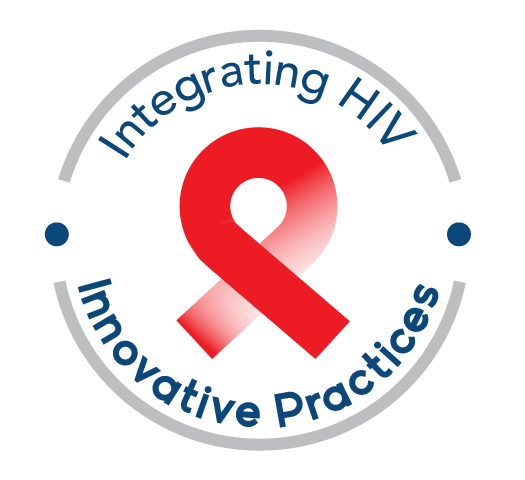 Session Length: 45 minutes
Session Length: 45 minutes
Materials Needed
- Computer and compatible LCD projector to play the PowerPoint presentation
- Whiteboard, large paper and easel, or other means of taking notes
- Colorful markers.
POWERPOINT PRESENTATION
SLIDES 1–3: Refresher — Overview of Pros, Cons, and Important Considerations for the Six Organizational Models
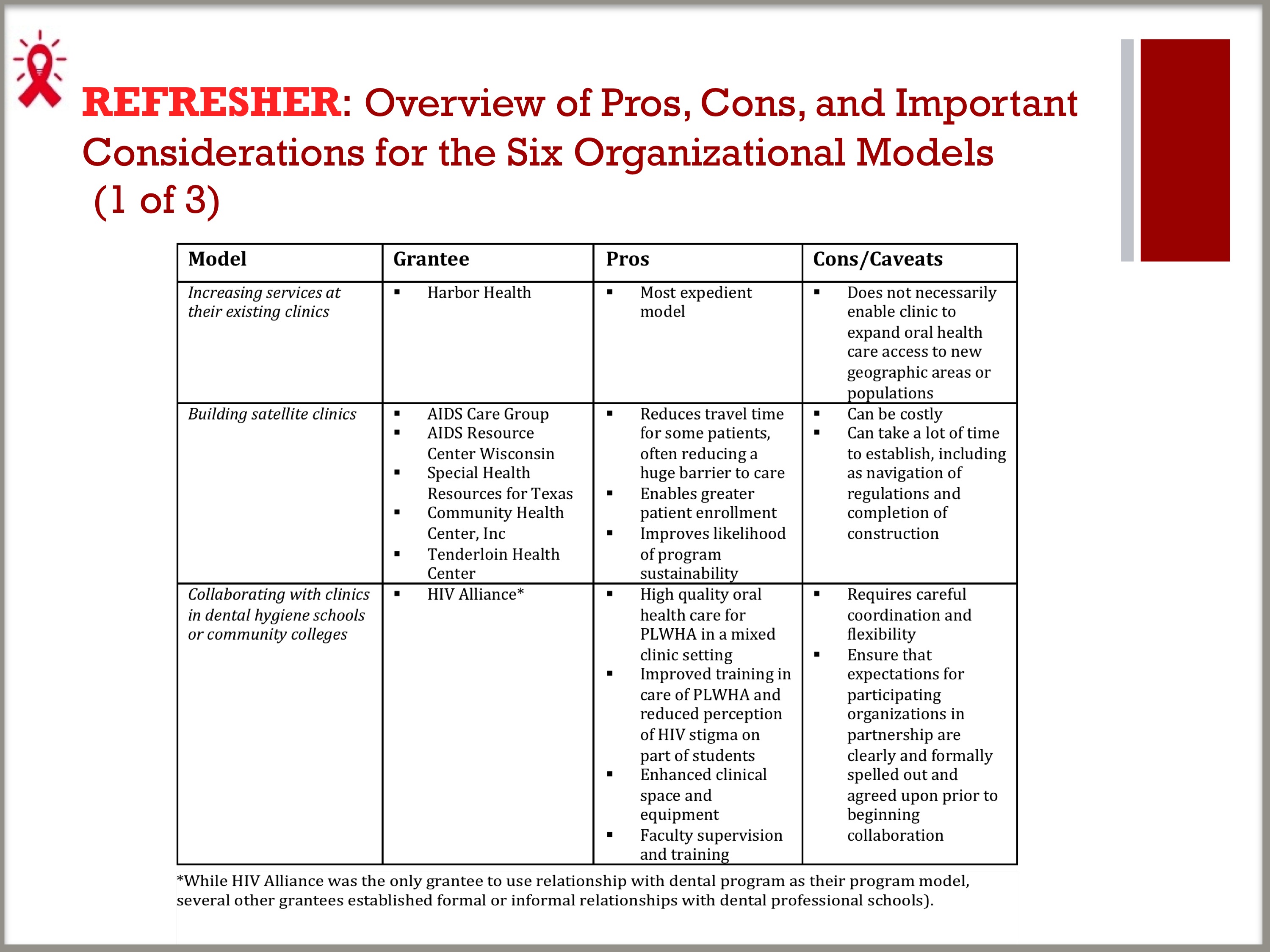
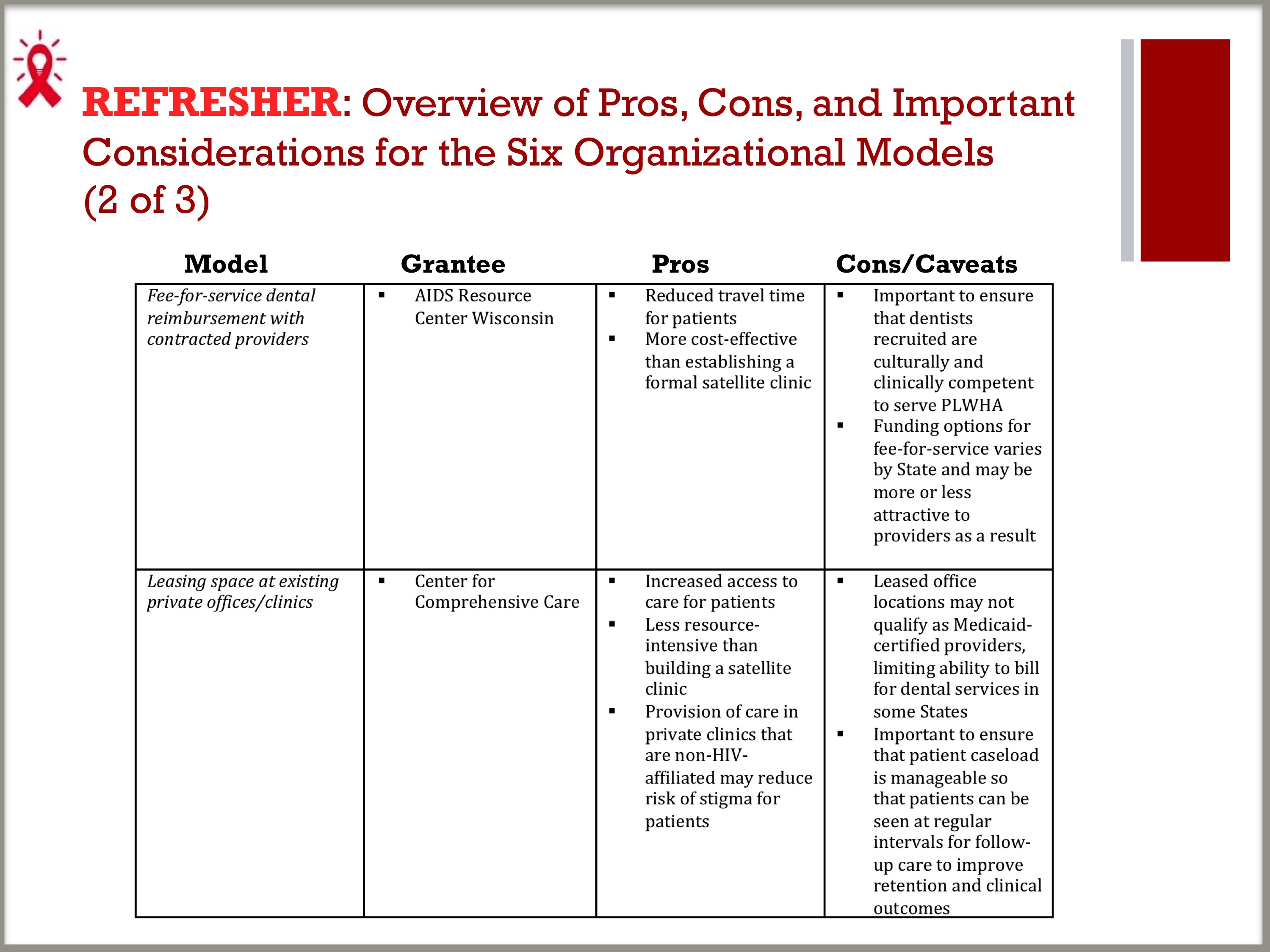
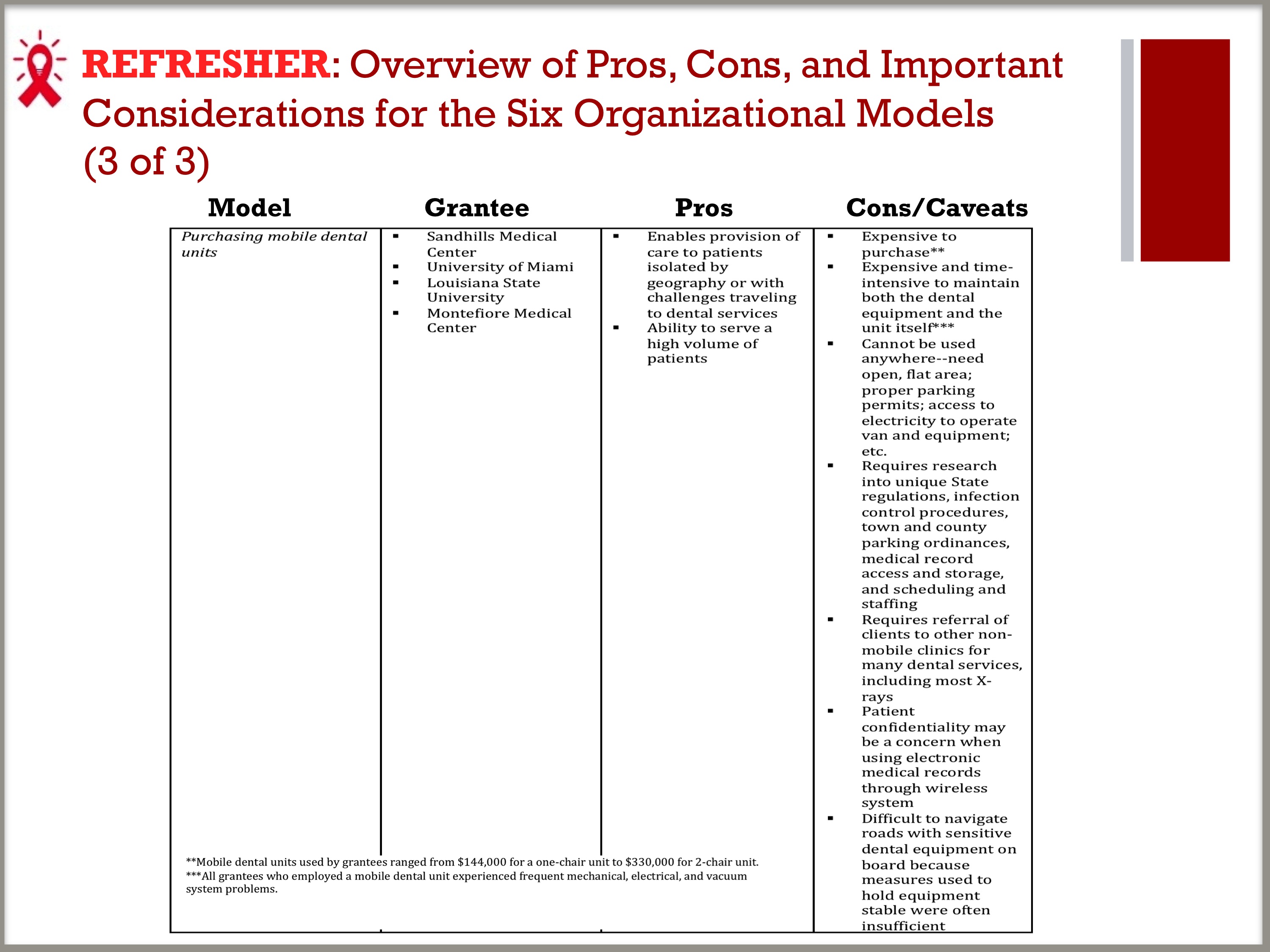
Briefly review the pros and cons of the 6 organizational models that were first discussed in module 3.
Overview of the Six SPNS Organizational Models Studied
| Model | Grantee | Pros | Cons/Caveats |
Increasing
services at their
existing clinics | | | - Does not necessarily enable clinic to expand oral health care access to new geographic areas or populations
|
Building satellite
clinics | - AIDS Care Group
- AIDS Resource Center
Wisconsin - Special Health Resources for Texas
- Community Health Center, Inc
- Tenderloin Health Center
| - Reduces travel time for some patients, often reducing a huge barrier to care
- Enables greater patient enrollment
- Improves likelihood of program sustainability
| - Can be costly
- Can take a lot of time to establish, including navigation of regulations and completion of construction
|
Collaborating
with clinics in
dental hygiene
schools or
community
colleges | | - High-quality oral health care for PLWHA in a mixed clinic setting
- Improved training in care of PLWHA and reduced perception of HIV stigma on part of students
- Enhanced clinical space and equipment
- Faculty supervision and training
| - Requires careful coordination and flexibility
- Ensure that expectations for participating organizations in partnership are clearly and formally spelled out and agreed upon prior to beginning collaboration
|
Fee-for-service
dental
reimbursement
with contracted
providers | - AIDS Resource Center Wisconsin
| - Reduced travel time for patients
- More cost-effective than establishing a formal satellite clinic
| - Important to ensure that dentists recruited are culturally and clinically competent to serve PLWHA
- Funding options for fee-for-service varies by State and may be more or less attractive to providers as a result
|
Leasing space at
existing private
offices/clinics | - Center for Comprehensive Care
| - Increased access to care for patients
- Less resource-intensive than building a satellite clinic
- Provision of care in private clinics that are non-HIV-affiliated may reduce risk of stigma for patients
| - Leased office locations may not qualify as Medicaid-certified providers, limiting ability to bill for dental services in some States
- Important to ensure that patient caseload is manageable so that patients can be seen at regular intervals for follow-up care to improve retention and clinical outcomes
|
Purchasing
mobile dental
units | - Sandhills Medical Center
- University of Miami
- Louisiana State University
- Montefiore Medical Center
| - Enables provision of care to patients isolated by geography or with challenges traveling to dental services
- Ability to serve a high volume of patients
| - Expensive to purchase**
- Expensive and time-intensive to maintain both the dental equipment and the unit itself***
- Cannot be used anywhere—need open, flat area; proper parking permits; access to electricity to operate van and equipment; etc.
- Requires research into unique State regulations, infection control procedures, town and county parking ordinances, medical record access and storage, and scheduling and staffing
- Requires referral of clients to other nonmobile clinics for many dental services, including most x-rays
- Patient confidentiality may be a concern when using electronic medical records through wireless
system - Difficult to navigate roads with sensitive dental equipment on board because measures used to
hold equipment stable were often insufficient
|
*While HIV Alliance was the only grantee to use relationship with dental program as their program model, several other grantees established formal or informal relationships with dental professional schools.
**Mobile dental units used by grantees ranged from $144,000 for a one-chair unit to $330,000 for two-chair unit.
***All grantees who employed a mobile dental unit experienced frequent mechanical, electrical, and vacuum system problems.
SLIDE 4: Finding Solutions to Common Barriers to Organizational Growth
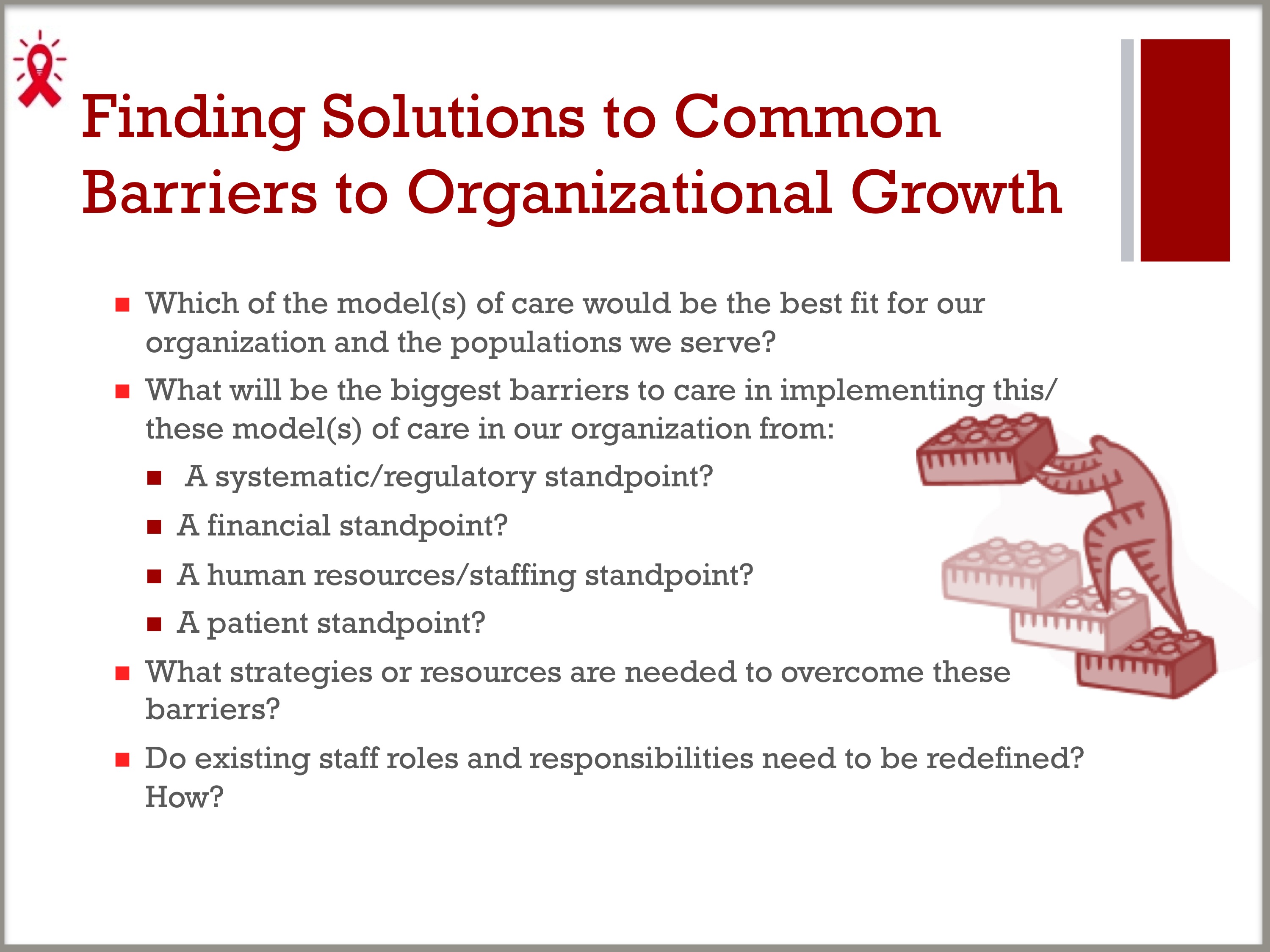
- Which of the model(s) of care would be the best fit for our organization and the populations we serve?
What will be the biggest barriers to care in implementing this/ these model(s) of care in our organization from:
– A systematic/regulatory standpoint?
– A financial standpoint?
– A human resources/staffing standpoint?
– A patient standpoint?
- What strategies or resources are needed to overcome these barriers?
- Do existing staff roles and responsibilities need to be redefined? How?
GROUP ACTIVITY
- Divide the class into 2 or 3 groups and provide each group with a large sheet of paper, markers, and an easel or tape to affix the paper to the wall.
- For 20 minutes, have each group address the questions listed in the PowerPoint slide, assigning one person in each group to take notes.
- Once the groups have finished taking notes, go through each question with the class, giving one person from each group the chance to share their group’s response to each question.
- At the end of the discussion, have the group vote on the top 3 to 5 initiatives or issues that the organization should undertake. Identify the key action items needed to occur to address these initiatives/issues and assign individuals to lead research into and implementation of the initiatives.
- Designate someone to schedule a followup meeting within the next 1 to 2 months to touch base on progress toward the stated initiatives.
 Session Length: 45 minutes
Session Length: 45 minutes



